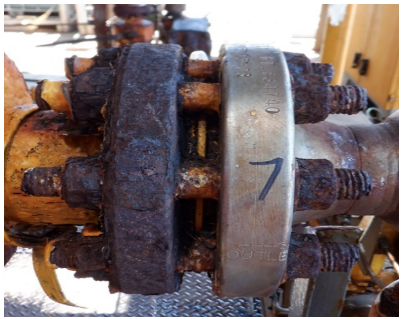Introduction
ASME PCC-2, Repair of Pressure Equipment and Piping, defines hot bolting or single stud replacement as “the sequential removal and replacement of bolts on flanged joints while under reduced operating pressure” [1]. Single stud replacement has historically been used predominantly for pre-shutdown activities which include removing, cleaning, lubricating, and reinstalling existing bolts. This process is intended to make flange maintenance more efficient, and thus provide a more predictable, effective, and assured plant maintenance shutdown.
Thorough inspection of the bolt is vital given the growing number of aging assets across the world; corrosion is a major issue (Figure 1). An increasing focus on the integrity of pressure boundary bolted flange joints has resulted in operators being more proactive in the replacement of corroded/degraded fasteners. While it would be desirable to perform this task during a maintenance shutdown period, this is not always possible, and operators are increasingly engaging in bolt replacement activities while the process remains online (live).
The key advantage of single stud replacement on a “live” line is eliminating the need for breaking containment. This typically means the operation can be performed with either limited or no disruption to production. It also means that the need for leak testing and return to service requirements are all reduced.

Figure 1. Galvanic corrosion effect on joint components with incompatible materials requiring hot bolting to upgrade bolts.
Single stud replacement is also employed to upgrade the material specification or grade of bolts due to the bolts having insufficient mechanical strength or an incompatibility with joint component materials. Furthermore, nondestructive testing (NDT) routines may also reveal fasteners having metallurgical defects (e.g., stress corrosion cracking). The location of such defects may not be visible to the naked eye or could be obscured by its location (i.e., masked by the flange or the gasket).


















Comments and Discussion
There are no comments yet.
Add a Comment
Please log in or register to participate in comments and discussions.